Overwhelmed by tech options? You are not alone
The promise of technology in the workplace is that it will allow us to do more with less, to be more productive or, dream of dreams, to have more leisure time. Remember when your laptop - or, more recently, your smartphone - was going to set you free? Of course, these dreams often do come partly true. But, as anyone who has ever instantly answered an urgent 3:00 am text message from an overseas colleague can attest, they often bring new challenges as well. This is the story of technology as told in a new survey of marketing executives released this week by US-based DNN Software. DNN undertook their survey of 300 marketing executives with mid-sized US companies. In the DNN survey, “mid-sized” means companies with between 50 and 5,000 employees - in other words, roughly the range between a good sized-language school and a medium-sized university. The introduction to the survey report sets out the context, and the challenge, for marketing managers in mid-sized companies:
“Marketers at mid-sized companies hold responsibility for a wide range of functions, from lead generation to analytics, from brand management to marketing strategy. Despite the formidable challenges of gaining and holding the attention of target audiences in an increasingly complex marketing landscape, they set ambitious goals for acquiring and retaining customers. Technology tools help, but mid-sized companies don’t have the IT support to integrate the solutions or the time to manage multiple vendors - even though the majority of them work with five or more solution providers.”
The DNN report finds that most marketing executives are trying to pursue several high-level marketing goals at the same time. “[The survey] paints a portrait of marketers who are trying very hard to do it all, do it now, and do it better than anyone else… When presented with a list of seven priorities for their marketing programmes, three-quarters of respondents give five of the seven items a high or very high priority rating.”
As the following chart illustrates, top priorities include acquiring new customers (87%) and retaining current customers (86%). This is perhaps not surprising but it does reflect what DNN characterises as an increasing integration of sales and marketing activities among responding firms.


“That means the future belongs to companies that can consistently generate solid content and target it to the specific, deliberately defined audiences they need to reach.”
DNN notes as well, however, that many firms struggle with sustaining effective content or social media marketing efforts, and that managing online tools and technology is a big part of this challenge. “While technology and metrics are central to any marketing programme,” the survey report concludes, “they can’t replace the day-in, day-out functions of listening, sharing, communicating, and building community at the heart of an audience-centred content marketing campaign.” DNN offers three closing recommendations to help address the growing complexity of managing multiple priorities and challenges (and often the tech tools that accompany an expanding marketing effort):
- Hire for complexity, focussing on prospective employees that are versatile and adaptable, and that demonstrate a real enthusiasm for learning and adopting new tools and processes;
- Start with strategy and let that lead all of your marketing efforts, rather than scrambling to keep up with the latest tools or online platforms;
- Choose integrated tools, where possible - that is, technology options that are part of an integrated suite of applications or that demonstrate a high degree of interoperability with your current or emerging systems.
Please see the complete survey report for additional detail and background.
















